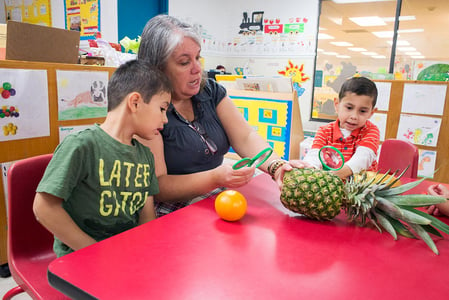
I’m often asked how teachers can improve the quality of their interactions around Instructional Support. That’s good! What’s not “good” is that we can’t just focus on one thing. We should consider how ALL the CLASS dimensions need to be in place in order to really provide effective interactions for Instructional Support.
So, how can you improve Instructional Support in the classroom by focusing on HOW you interact with children?
Set the Stage for Effective Instructional Support Interactions
Start with your children. Get to know them, inspire feelings of safety and trust. Show them you are interested in them, listen—focus on what they are saying to you with words or behavior.
Provide an organized classroom that allows plenty of time for you to interact with them. Use interesting materials or modalities to draw their interest in so you can capitalize on the teachable moments.
Every day, all day, children tell us what they need by their behavior, their responses to us–our job is to be good at noticing these messages. Highly effective teacher-child interactions are essentially Developmentally Appropriate Practice. Teachers just need to take a moment, observe, and respond.
Let’s think about a few dimensions that are the springboard for Instructional Support:
Teacher Sensitivity ---> Quality of Feedback
When teachers are aware of children’s understanding or challenges with a task, an idea, or a concept, they can provide scaffolding to help the child understand.
Regard for Student Perspectives ---> Concept Development
When teachers seek out the children’s ideas, points-of-view, or interests, they can shape their planning around the concepts that the children are ready to learn about.
Instructional Learning Formats ---> Instructional Support
When teachers actively facilitate children’s engagement they set the stage for focused learning.
Improve Instructional Support in Your Classroom
Start by connecting with your kids. Learn about who they are and what they know or don’t know about how the world works. Be sensitive to their needs both emotionally and academically. Adjust your plan to meet their needs.
Provide a chaos free environment by having interesting materials, a clear flow to the day, and minimal waiting throughout the day. Notice what they play with, how they use materials, and what captures their imagination.
For example, here are three Instructional Support areas you can focus on, as well as an example for how to incorporate them into your classroom:
- Integration: Ask questions to get them to think out loud. “I noticed you were making a farm with these blocks and farm animals, have you ever been on a farm?
- Analysis and Reasoning: Get them to think about the how and why of learning. “What do you think these animals would need on a real farm to be taken care of?”
- Parallel talk: Describe what they are doing, “You are lining up all the cows in a long row. You are putting them in order.”
Instructional support interactions matter and you have many opportunities throughout the day to do just that! Interact, pay attention, respond to the children where they are, and take it to the next level with intentional responses. You will find your time with children will be more engaging and fun!

